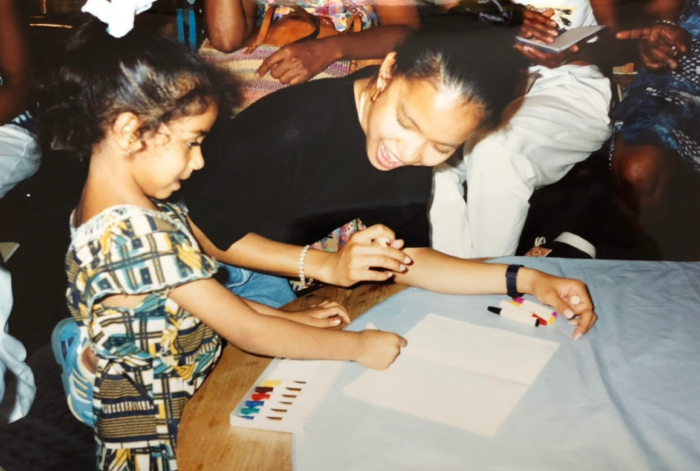Q&A With Akua Hill
Building OpportunityArts & CultureOct 15, 2024

In this edition of Q&A, we talk with Akua Hill, the Gilbert Family Foundation’s new Director of Arts & Culture. Hill talks about how her experience growing up in the arts community in Harlem had a profound impact on the way she views the role of art and culture in shaping opportunity, and the lessons that we can learn from artists and creators as we look to build more resilient communities. A certified yoga instructor, Hill also highlights the way her yoga practice has encouraged more mindfulness and appreciating where we are in the present moment.

Q: What previous experiences have most influenced your approach to arts and culture?
A: Art and culture have both been an integral part of my life since childhood. Growing up in NYC allowed me to not only witness but engage with so many different identities, and forms of cultural expression and practice. Raised by a mother who made a bold choice to pursue a career as an artist, and a brave choice to be an activist, I got to experience firsthand the power of cultural organizing – particularly amongst Black communities in Harlem and Brooklyn, during a time when their needs and voices were not often heard or considered. I saw my mother and her peers use creativity and culture as tools to affirm community and ancestral pride, create safe and liberatory spaces for their children to grow and learn in, and to preserve their identity, neighborhoods, traditions and livelihood. In retrospect, the most fascinating part of this experience was seeing how they developed culturally reflective strategies to address critical community challenges, together. They organized to prevent the displacement of residents and businesses, advocated to protect valued cultural institutions, encouraged and created opportunities for artistic expression and social impact, established a community school grounded in culturally reflective curriculum and values of community care, opened a jazz club to support the school, designed reoccurring events/gatherings centered around education and celebration – some that still continue to this day, built businesses based on principles of cooperative economic development, cultivated a community garden, and more. Art and culture was embedded in the fabric of their efforts. They made it their responsibility to create the community conditions which not only illuminated their heritage but also supported the wellbeing of the collective. These were my first models of culture bearers, community leaders, change agents – but most importantly, they were my village.

Q: As a native of Harlem, how do you think the arts scene is different or similar from Detroit’s?
A: I think there are some special similarities that Detroit and Harlem share when it comes to their respective art scenes. Historically, both places have been epicenters for Black creativity; fertile ground for artists and culture shapers to carve out space to reflect their lived experiences and dreams, to be seen and affirmed, and to center joy. While the arts ecosystems in both places have illuminated Black creative expression, they have simultaneously provided opportunities for entrepreneurship, economic mobility and power-building that has not always been as accessible in other cities. Celebrated for artistic vibrancy and innovation, cultural authenticity and pride, both Detroit and Harlem have established deep cultural influence that continues to reverberate across generations and geography. These kindred creative communities can be looked to as a birthplace for important artistic movements and contributions worldwide, even to this day. In my opinion, the rich cultural fabric that exists in both places has an undeniable staying power – rooted in a spirit of resilience, of way-making, and of creative agency to imagine and shape new realities. For these reasons and more, I’m grateful to call both of these places home.
Q: How do you envision the Gilbert Family Foundation’s role within the local arts community?
A: I see our role as one which strategically supports and amplifies Detroit’s unique arts and culture ecosystem, as well as identifies the opportunities which would help strengthen and grow its impact. Our responsibility is to ensure that our investments benefit Detroiters and Detroit’s creative community. I see this happening by making investments that support all Detroiters having access to arts and cultural experiences across the city, including in their neighborhoods. By supporting more cultural activations in neighborhoods, it will also stimulate place-based pride and connection, economic growth and stability, as well as community belonging and vitality. In order for those outcomes to become a reality, I envision supporting artists to be able to create and scale their work, have access to relevant capacity-building opportunities, and create spaces for artists to connect with and support one another. as well as building the infrastructure that will make it possible for artists to see Detroit as a place where they can grow and establish a thriving career.
Q: How do you see the role of arts and culture evolving in the next decade?
A: I see the way in which people perceive and support the role of arts and culture evolving significantly. I am excited for the narrative about arts and culture to shift from being just “nice to have” and “enjoyable” to also include “tools for social change” and “indicators for community vitality.” I am looking forward to the ways in which people think about cultural ecosystems to expand. I think more and more people are seeing the impact of arts and culture as a driver of community development, economic mobility and social connectivity and belonging. A tool for organizing, healing and telling stories that are sometimes silenced. I envision artists embracing and being embraced for their roles as change agents – disrupting antiquated systems and working within communities to build new systems using innovative and culturally inclusive solutions. I imagine creative and culturally inclusive practices being intentionally woven into the intersections of more industries in need of deep transformation. Whether it be environmental justice, housing, mental health, education or civic engagement, I see artists and culture bearers pushing the boundaries of what has been done to reimagine what is possible and design the pathways to healthier, more inclusive and more sustainable futures. Lastly, I see forthcoming change in the way that arts and culture is valued and resourced. More efforts to support creative workers having a livable wage, protected funding in local and national budgets, as well as arts and culture strategies built into city planning and community growth models.
Q: We hear you’re a yoga instructor. Any life lessons learned from this passion?
A: Yes, I was certified in Kripalu Yoga in 2013! One of the many lessons that yoga has taught me is about the importance of being present in the moment. It can be really easy to get consumed with thinking about the past – whether it’s nostalgia, or trauma, or regret, or someone we miss deeply. We can also get caught up thinking about the future – what we hope to accomplish, or things we desire to have, anxiety about an upcoming event/task, worrying if we will become the person we strive to be. All of those thoughts prevent us from being present in the moment and being able to appreciate all that we are and all that we have right now. In yoga, I am reminded of this because we are encouraged to let each posture go, once it is complete. Whether you did a “good job” holding the posture, or feel disappointed that you didn’t fully nail it, if you continue to think about it while attempting to hold the next posture, you are preventing yourself from being present and being able to focus on doing your best with what is in front of you.